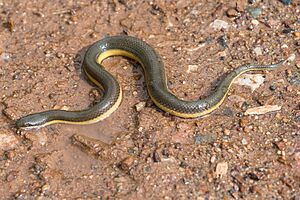Rice paddy snake facts for kids
Quick facts for kids Rice paddy snake |
|
|---|---|
 |
|
| From Phetchabun Province, western Thailand | |
| Conservation status | |
| Scientific classification | |
| Genus: |
Hypsiscopus
|
| Species: |
plumbea
|
| Synonyms | |
|
|
The rice paddy snake (scientific name: Hypsiscopus plumbea) is a type of snake that lives in water. It is also known as the grey water snake or Boie's mud snake. This snake is found mostly in South Asia. It is quite common and lives in many wet places across Asia. It has a mild venom, but it's a "rear-fanged" snake. This means its fangs are at the back of its mouth.
About the Name
The scientific name for this snake is Hypsiscopus plumbea. The word plumbea means 'lead-like'. This name describes the snake's upper body, which is often a greyish color, similar to lead.
Scientists are still studying these snakes. They think there might be different kinds of rice paddy snakes that look very similar.
What Does It Look Like?
The rice paddy snake is a fairly small snake. It can grow up to about 72 centimeters (about 28 inches) long, including its tail.
This snake has special coloring called countershading. This means its top side is dark, usually dark brown or grey. Its belly is light, often white or yellowish. This helps the snake blend in with its surroundings. Some rice paddy snakes might even have a greenish color on top. Others might have dark spots along their back.
The rice paddy snake is mostly active at night.
Where Does It Live?
The rice paddy snake lives in many countries in Asia. You can find it in places like the Andaman Islands (India), Myanmar, Thailand, Cambodia, Laos, Malaysia, Indonesia, Vietnam, southern China, and Taiwan.
This snake loves wet places. It is very common in many different watery homes. These include rice paddies, ponds, and other damp areas.
What Does It Eat?
The rice paddy snake is a hunter. It mainly eats small fish and frogs. Sometimes, it might also eat small lizards.
Gallery
-
Hypiscopus plumbea at Nong Phai District, Phetchabun Province, Thailand
-
Hypiscopus plumbea
from Karawang, West Java





